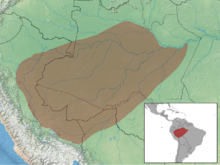Steere short-spiked rat
| Steere short-spiked rat | ||||||||||||
|---|---|---|---|---|---|---|---|---|---|---|---|---|
| Systematics | ||||||||||||
|
||||||||||||
| Scientific name | ||||||||||||
| Proechimys steerei | ||||||||||||
| Goldman , 1911 |
The Steere-Kurzstachelratte or Steere-Stachelratte ( Proechimys steerei ) is a rodent from the family of the sting rats (Echimyidae). The kind epithet honors the American naturalist and ornithologist Joseph Beal Steere , who collected the holotype in 1901 .
features
The Steere short-spiked rat has a head-trunk length of 215 to 493 mm, a hind foot length of 49 to 63 mm, an ear length of 20 to 26 mm and a tail length of 120 to 207 mm. The average weight is 450 g, but specimens weighing 800 g were also caught. The back fur is light reddish brown and only weakly dashed with dark hair. A dark central dorsal stripe, which is characteristic of the Napo short-spiked rat ( Proechimys quadruplicatus ), is largely absent in the Steere short-spiked rat. The peritoneum is pure white and its texture is more velvety, both when viewed and when touched, than that of other species of spiny rats. The soft dorsal fur spines are about 15 mm long, about 0.5 mm narrow and have whip-like tips. The coat is considerably softer than in sympatric echimyidae species of the genus, including other members of the Proechimys-goeldii - species complex . The two-colored tail is dark on the top, light on the underside, covered with fine hair and conspicuously scaled. The surface of the hind feet is clearly two-tone. The outside is light to dark brown and the inside is whitish from the tarsus to the tips of the toes.
Distribution area
The distribution area extends from the Amazon basin south of the Río Marañón in eastern Peru, over northwestern Bolivia to western Brazil, largely south of the Amazon to east above the Río Purus and north of the Amazon to the Innerí region west of the lower reaches of the Río Negro .
habitat
The Steere short-spiked rat inhabits seasonally flooded rainforests in the dry season , particularly the black water rivers of the Igapó Forest and the white water rivers in the Várzea , and in the rainy season the edges of the adjacent terra firme rainforests , including secondary forests , overgrown gardens, river banks and flooded grasslands in forests at altitudes of 50 to 400 m.
Eating behavior
The diet of the Steere short-spiked rat consists of fruits, mushrooms and seeds. Occasionally plant material and arthropods enrich the food supply. The consumption of Sporocarpen of mycorrhizal fungi suggests that the Steere short spiked rat a key ecological role in the dissemination of seeds and mushrooms in the woods.
Reproductive behavior
A long-term study from 2000 on the Rio Juruá in western Brazil came to the conclusion that the steere short-spined rat has a higher reproductive rate than most other representatives of the short-spined rats, which is probably related to the temporary availability of the primary, seasonally flooded habitat. Both sexes reach sexual maturity at an early age, well before the transition to adulthood. Pregnant females of average age were comparatively younger than the Simon's short-spiked rat ( Proechimys simonsi ) in the adjacent Terra Firme rainforest. 18 percent of the pregnant females examined had a simultaneous gestation and lactation period.
status
The IUCN classifies the Steere short-spined rat in the category “not endangered” ( least concern ). It is widespread and, due to its specialization in near-rivers, seasonally flooded forests, a threat from habitat loss is currently unlikely.
literature
- James L. Patton , Rafael N. Leite: Genus Proechimys JA Allen, 1899. In: James L. Patton, Ulyses FJ Pardiñas and Guillermo D'Elía (Eds.): Mammals of South America, Volume 2: Rodents. The University of Chicago Press, Chicago, 2015, pp. 950-988
- Pierre-Henri Fabre, James L. Patton and Yuri Leite: Family Echimyidae (Hutias, South American Spiny-rats and Coypu). In: Don Ellis Wilson and Russell A. Mittermeier (Eds.): Handbook of the Mammals of the World. Volume 6: Lagomorphs and Rodents 1 Lynx Edicions, Barcelona 2016, ISBN 978-84-941892-3-4 , p. 612
Web links
- Proechimys steerei inthe IUCN Red List of Threatened Species 2018.2. Listed by: J. Patton & A. Percequillo, 2016. Retrieved March 11, 2019.
Individual evidence
- ↑ Marjorie Matocq, James L Patton, Maria Nazareth F. da Silva: Population genetic structure of two ecologically distinct Amazonian spiny rats: separating history and current ecology. Evolution, 54 (4), 2000, pp. 1423-1432
